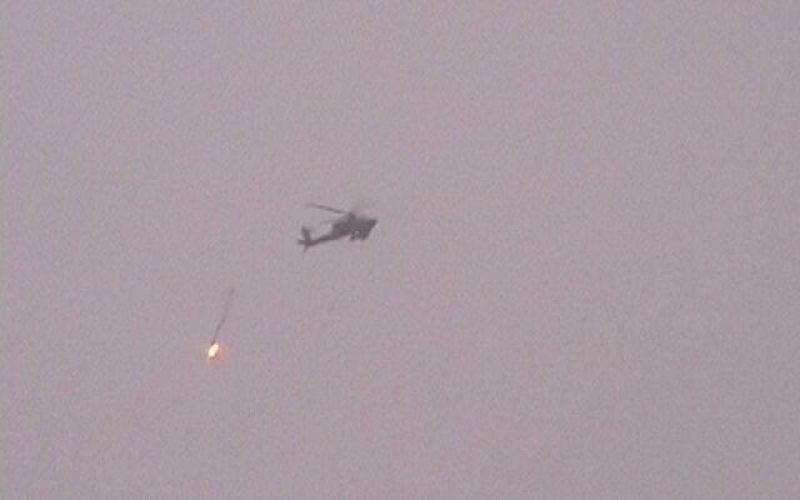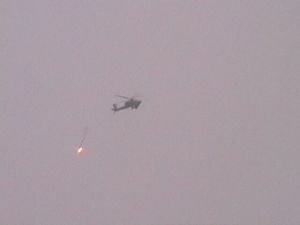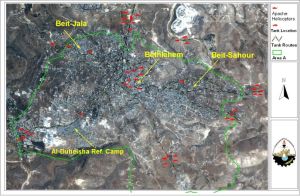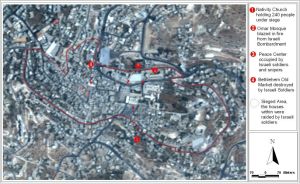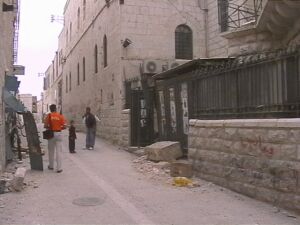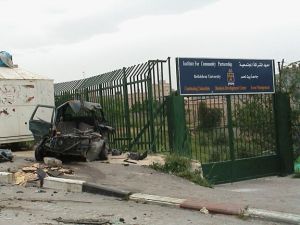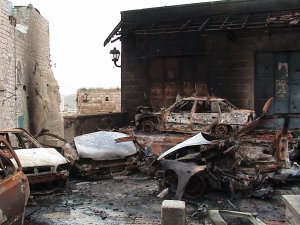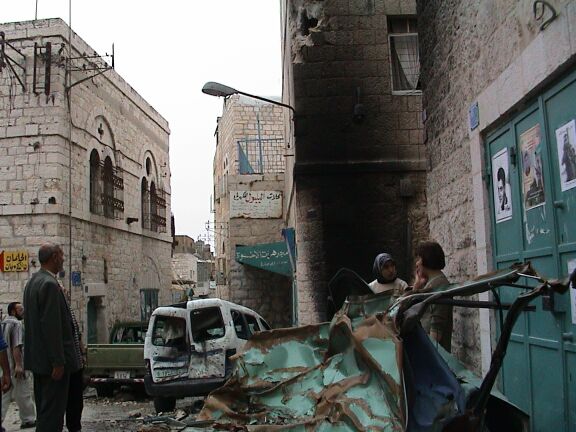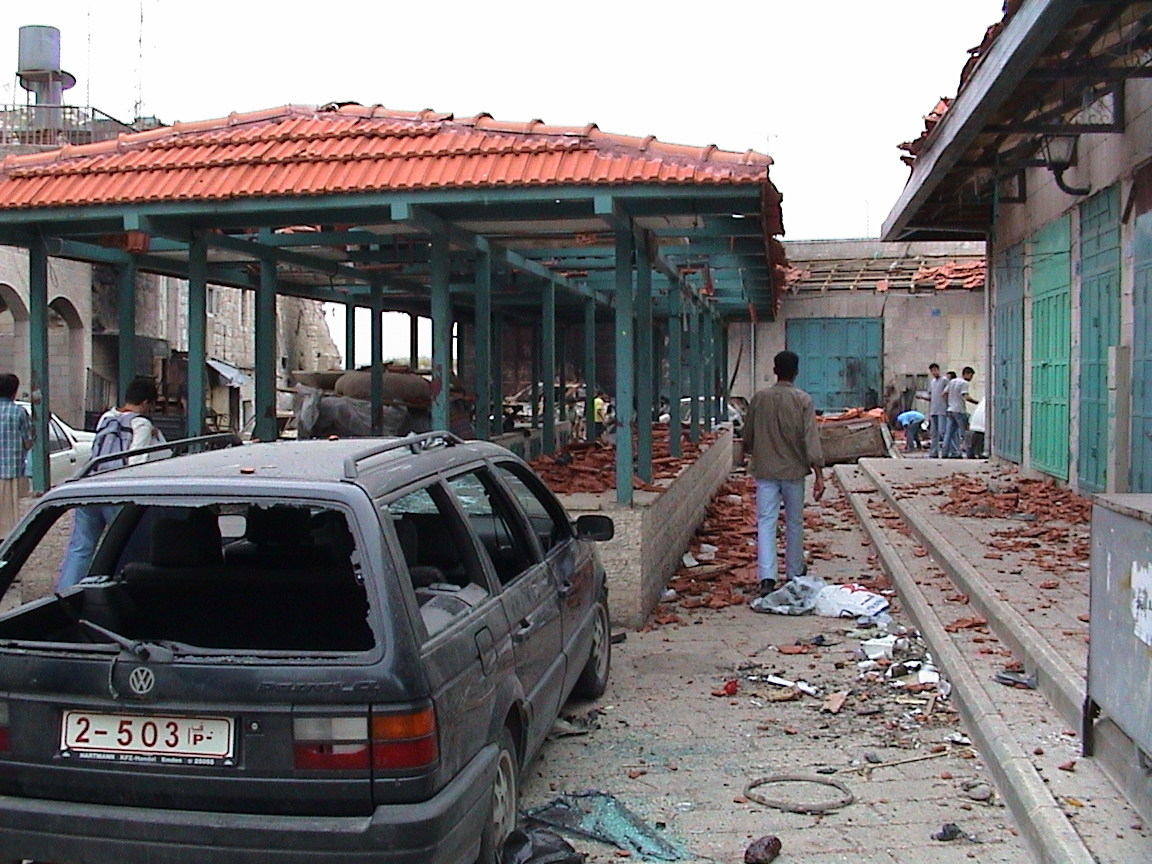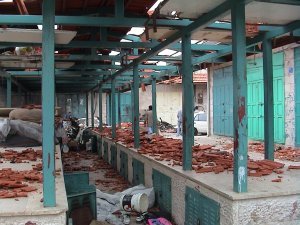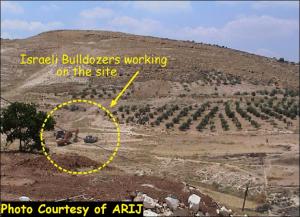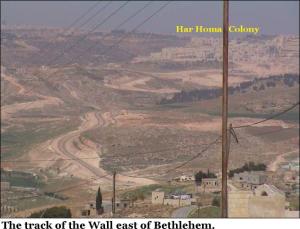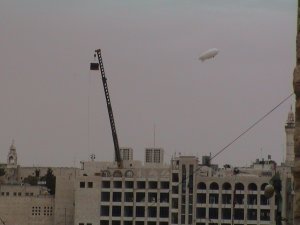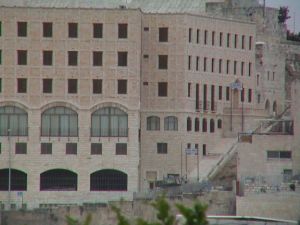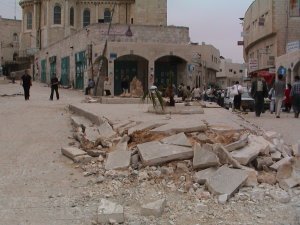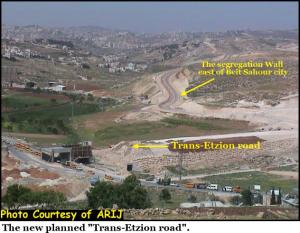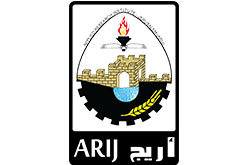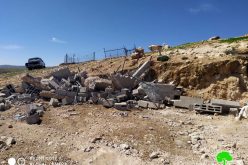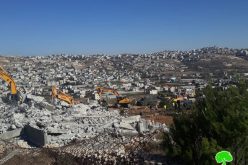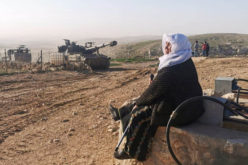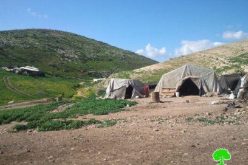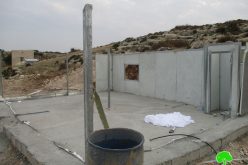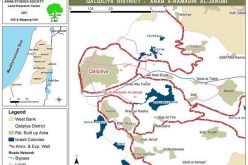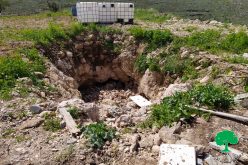On Friday 29 March, 2002 which coincided with Good Friday according to the Western calendar, the Israeli army started its fourth invasion of the Bethlehem district in less than six months. Two thousand years ago, Jesus, an early Palestinian martyr, was crucified and killed by the occupation forces for his resistance to the occupation of his land and people. Many are asking the question: Is history repeating itself?
The Israeli occupation army has imposed an unprecedented harsh siege on Palestinians throughout the West Bank and Gaza including their democratically elected President whose offices in Ramallah, except for two rooms, were bombed and destroyed by rockets fired by the Israeli army from American made F16 fighters and Apache helicopters.
ARIJ usually closes its offices on Easter. Thus, on Saturday 30 March, ARIJ was officially closed. However, a number of ARIJ staff felt that a large scale invasion of Bethlehem is underway. This was evident from the large number of tanks and troop carriers that started moving towards Bethlehem and the number of buildings that were taken over by the Israeli snipers in key locations in Beit-Jala, Doha and Aida refugee camp. On the same day, Kuwaiti NGO's were organizing an event in solidarity with the Palestinian people which included a presentation on the issue of settlements by the director general of ARIJ, who has just come back after attending a conference on science and technology in the Arab world in the United Arab Emirates. Realizing the gravity of the situation and the need to be in Bethlehem immediately, the director general declined from attending the event in Kuwait and sought to send the presentation by email. Thus, on Saturday morning, the presentation was made and sent to the organizers of the conference in Kuwait. Other ARIJ staff members worked that day preparing themselves for the coming days. Usually, this means taking reading material or computer files for two or three days. Unfortunately, all the staff underestimated the length of the crisis which now has been going for sixteen days. In the past three reoccupations, ARIJ managed to continue its activities and adopted a contingency plan that allowed it to perform. Regrettably this time, ARIJ was unable to cope with the situation.
100 internationals including Italians, British, American, Palestinians, and other European citizens marched in the streets of Beit Jala to protest against the Israeli invasion of the town. The march approached the Israeli tanks with signs calling for an end to the Israeli occupation. The peaceful demonstrators were attacked with sound bombs and bullets shot by the Israeli soldiers wounding six protesters. In Manger Square, some 200 Italians arrived from Jerusalem to express solidarity with the Palestinians. The protestors later decided to disperse themselves and stay with Palestinian families in the three refugee camps. Arrangements were made with the popular committees in the camps to host them.
On Easter Sunday, 31 March, 2002, the Israeli heavy tanks and troop carriers moved deep in Beit-Jala, Al Khader and Doha as well as Aida and Dheishah refugee camps. Bethlehem and Beitsahour remained untouched. Thus, ARIJ opened its offices on Monday for those who could report to work. Laila Saqqa, Nadine Hassassian, Roubina Ghattas, Raed Abed Rabbo and Leslie Berkley had to stay under the curfew imposed on their areas and could not come to ARIJ. Dr. Mohammad Ghanayem, Nezar Farsakh and Suad Istanbuli were unable to get to ARIJ because of the tight siege on Bethlehem district. Still, ARIJ was able to have a normal work day but surely with reduced efficiency.
By 10 pm on Monday, 1 April 2002, the Israeli forces started its systematic obliteration campaign of the people, infrastructure and the livelihoods of the civil society as well as of the Palestinian Authority in Bethlehem. It first started with a drone that flew all over the area to make reconnaissance surveys which was followed by two Apache helicopters which flew over the area firing heavy caliber machine guns all around the district (Figure 1)
Figure 1: An Apache helicopter attacking the Manger square
Simultaneously, more than 200 tanks and armed vehicles moved from all directions towards the heart of the city of Bethlehem (Figure 2).
Figure 2: A map of the fourth invasion of Bethlehem on 31 March, 2002
As these vehicles were moving in, they were destroying cars, electricity poles, water pipes, telephone lines and boxes among others. By 3:30 am on Tuesday, April 2, 2002, and with very little resistance from Palestinian gunmen, the Israeli heavy tanks and armored vehicles were stationed all around the Manger Square and its vicinity, thus encircling the little town of Bethlehem, (Figure 3))
Figure 3: The besieged little town of Bethlehem
During this raid, the Lutheran Church in Bethlehem was hit damaging a number of its rooms while many of the sintered glass painting in the church were also shattered. The Assyrian Church as well was severely hit as shown in the following pictures. see figures below
Figure 4: Destruction of the entrance of the Lutheran Church
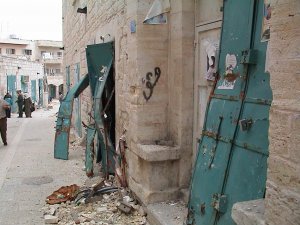
Figure 5: Destruction at the rear of the Lutheran Church
Figure 6: The Assyrian Church under fire
Most of the Palestinian gunmen found themselves trapped in a small area around the Manger square and were subjected to fierce shooting from the air, the tanks and the snipers who occupied key locations around the Manger square. In the first few hours of that day twelve Palestinians were shot dead even though realistically not posing a threat to the lives of the heavily armored Israeli soldiers. Fearing for their lives, the Palestinian gunmen and civilians sought refuge in the near by churches and mosques. Omar mosque in the Manger square was hit by Israeli fire and went in flames forcing Palestinians to move to other safe religious places. The Israeli army prevented the Palestinian firemen from extinguishing the fire. Those who entered Saint Maria church in Madbasa did not escape the indiscriminate shooting of the army which led to the injury of six nuns and one priest as well as Palestinians. As the news spread, Palestinians sought refuge in the church of Nativity, which has provided refuge to people of all sorts of religions and races through out the ages. Consequently, around two hundred and forty Palestinians including the governor and the head of the crisis management committee as well as the tourism police entered the church of Nativity while they were under fire from the Israeli army. A curfew was imposed on the Bethlehem district and the Israeli forces started raiding houses and buildings, terrorizing the civilians, devastating their houses, and destroying personal belongings as well as detaining large numbers of the population.
On Tuesday 2 April, the Israeli army raided Bethlehem University and converted its playground to a detention and interrogation center for those who were systematically arrested (Figure 7). Then they moved to the Presidential compound in Bethlehem blowing its doors and moved the detainees to the compound. So far, close to 1200 Palestinians were arrested of whom close to 500 have been detained and transferred to prison without any charges. Among those arrested was the deputy governor of Bethlehem and a number of his assistants. Immediately following their arrest, they were blindfolded and handcuffed before they were transported to the occupied palace. It is worth mentioning here that no lawyer is allowed to see any of the detainees for 18 days which has exacerbated the sufferings of the detainees and their families. Those who were arrested and released told horrible stories about the torture and humiliation that they were subjected to.
Figure 7: Bethlehem University under attack
The living conditions in the district started to deteriorate. The 101 emergency line was cut. Tens of cars have been destroyed by tanks including an ambulance car. Tens of electricity poles were brought to the ground and main water pipes were destroyed. Half of the city became without electricity or water.
In the following days, the Israeli army reinforced its presence around the Manger square which became hermitically sealed off. The Peace center, Bethlehem municipality and the Russian Church Hotel were occupied by the Israeli army which detained a number of civilians, reporters and municipality employees who were in these buildings. The Red Cross has been denied access to the whole compound and was unable to provide any food or medicine to the besieged people from 1st of April until the date of writing this report. Among those inside the church of Nativity, there are ten wounded people with one seriously wounded. Attempts to evacuate the wounded or provide medical aid were rejected off right by the Israeli army. Those under siege were subjected to additional psychological pressure that started by denying them sleep. Throughout the day and night, the Israeli army was shooting regularly around the church and used loudspeakers to issue warnings and threats. The small door from the Church of Nativity towards the Milk Grotto Street was blown by the army which caused havoc among the besieged Palestinians who went to defend the premises resulting in two additional injuries inflicted by Israeli snipers. On Thursday, fire broke out in one of the rooms adjacent to the church of nativity as a result of Israeli shooting. One of the besieged persons tried to extinguish the fire but was immediately killed by an Israeli sniper. The Israeli army refused to allow the Red Cross to move the body of the martyr for burial. The Orthodox Church proposed to bury the body temporarily in the Nativity Church garden. The body was put in a coffin and the clergy carried it to the burial ground but the Israeli army fired at the clergy and wounded a clergyman in the chest.
On Wednesday, 3ed of April, we started to call each other to check on ARIJ stuff living in the area. Nasser lives in al Fawaghra area near al Madbasa. This area is within the Nativity church compound that has been totally blocked by tanks armored vehicles. Soldiers raided the Fawaghre area and arrested a number of persons. During this raid, several houses were demolished and vehicles were burnt. The old market was totally destroyed, (See Figures Below
Destruction in Fawaghrah neighborhood
Destruction of the old Bethlehem
Figure 12: A house in Fawaghrah hit by an Israeli tank shell
In addition, they killed a 60 years old lady and her 38 years old son as they raided the two rooms house of Sami Mousa Abdeh. there was no justification whatsoever for the killing of these civilians as Nasser said. His concern was that the two bodies need to be moved immediately to the murge or be buried since their presence in the house in front of the children was causing a hysteric situation. Calls were made to the Red Cross, the consuls generals in Jerusalem and later to other international agencies and some congressmen. Regrettably, it took 27 hours before the evacuation took place. why all that delay? No one knows but someone said that the Israeli officer in charge was adamant in his rejection of the request saying to those who were interceding ' Over my dead body' .
After a number of calls, it was found that all ARIJ staff are fine and are coping with the situation. The only concern is that Miriam Salahat lives in the manger square area where there electricity and water are out and the Red Cross is unable to provide food or medicine to them. Nevertheless, it was she who initiated the call to check on everyone at ARIJ. Her cousin was killed during the first day of the invasion but she has not been able to pay condolences to his family. Every attempt was made through the Red Cross, church groups and other international agencies in an attempt to provide Miriam and her family with some supplies but with no success so far when this report was made. This means that for fifteen consecutive days, all the residents in the Manger square compound have been denied access to food, water, electricity and medicine. When will they get it???
On the 4th of April, a number of internationals were evacuated from Bethlehem by their diplomatic representatives. The municipality of Beitsahour was raided blowing the main door beforehand and destroying a number of doors and windows.
The bells that rang on a daily basis since the Nativity church was built and the people of the holy city who chanted along with the priests of the nativity their prayers for peace were denied their right to perform their rituals. Not that they did not attempt to but because the person who sought to ring the bells was shot down by an Israeli sniper. Since the construction of the nativity church before sixteen hundred years, religious masses were not interrupted. All the invaders of the holy land, including the Ottomans did not denigrate the nativity church which was usually used by the Bethlehem inhabitants as a shelter during all the previous wars. In this invasion, the Sunday masses of April the seventh and the fourteenth were cancelled, two persons were shot down in the church and another four were seriously injured within 15 days of military siege. Only on 15th of April did the Israeli army allow the Red Cross to move the bodies of the two martyrs from the Nativity Church.
Keeping up with its reputation as a brutal force disrespectful of the Geneva conventions, the Israeli forces reportedly stole currency and Jewelry from sixty six houses in Bethlehem. It should be noted that locals withdrew money from bank accounts before the invasion to keep hold on some cash much needed to obtain essential goods and medicine.
On Friday the 12th of April, the Israeli forces again raided Beitsahour and arrested a number of its inhabitants. They came to Wadi Abu Sa'da and raided the building of Atallah Hayek which contains rented apartments. Two tenants opened their doors for the army to search and found nothing but they insisted on searching the whole building. The tenants told the army that they have no keys for the rest of the apartments but the army insisted to have the doors opened immediately otherwise they will blow them open. The tenants called the landlord and described to him the situation. He told the tenants to tell the army that he will come immediately. As he approached the soldiers, they shot him. The army refused to allow the ambulance car to carry him to a clinic or hospital for one full hour and by the time he reached the clinic, he has bled to death. A neighbor who tried to come to help was beaten by the soldiers. His mother Zahra Abu Sa'da (74 years) could not tolerate what is happening and she just collapsed dead. No comment from the Israeli forces on the cold blooded murder of Mr. Hayek was issued. This has left the citizens of Beitsahour with the conviction that this is an all out annihilation war on Palestinians targeting civilians and dispatching terror in the hearts of ordinary civilians.
The situation until the date of writing this message is an escalation of more of the same. The Israeli army is keeping the Manger square area under total blockade. Psychological pressure on the besieged persons is escalating. In addition to the continuous shooting and loudspeakers that deny the besieged the opportunity to sleep, the Israeli army is introducing high tech devices to disturb them. On the 12th of April, the army brought weather like balloons and flew them over the Manger Square. Since then, mobile telephones stopped functioning properly. On the 13th, the army fenced all around the compound and brought boxes that emit loud noises of sirens and other things that even those living more than 300 meters away from the compound found it irritating. On the 14th of April, the army brought a huge crane to the Manger Square and used it to place containers all around the Nativity Church. In each container, there is a number of Israeli snipers equipped with listening devices and other gadgets (Figures 14 to16). These events were taking place while the Secretary of State, Collin Powel was meeting President Arafat in Ramallah. Israel gave the besieged two options either to be exiled for ever or surrender to the Israeli army. Neither option is acceptable to Palestinians. It is worth mentioning here that St. Jerome sought refuge in the Nativity Church in 416 AD during which he was welcomed as a guest for three years.
Figure 14: A container that was placed at the main entrance of the Church of Nativity
Figure 15: The balloon and the crane
Figure 16: An Israeli tank in front of the Casanova hotel
of the Nativity Catholic Church
Raids on Palestinian communities are still going on and more arrests are being made. On Monday, the 15th of April, the Israeli army raided Obeidiyyah and Doha killing two persons. Two houses in Beitsahour were torched by the Israeli army in the city center. For the first time in two weeks, the curfew will be lifted between 11 am and 3 pm on Bethlehem district except for the Manger Square area. The Church of Nativity is not visible today as the army used smoke bombs to mask it. Smoke may hide the Israeli atrocities for an hour or so but it will not be able to hide the truth of what is going on. We wished that Mr. Collin Powel seize the opportunity of his visit to come to Bethlehem or to go to Jenin to see what Israel is doing with American arms.
For two weeks, ARIJ was unable to perform as an applied research center but its staff found alternative means and ways to serve their community. ARIJ staff are instrumental in food and medicine distribution each in his or her neighborhood. A number of ARIJ staff are working with the Governorate of Bethlehem in organizing food aid and other services. Today is the first time that some of the staff were able to come to the institute since 30 March. ARIJ's server went down when electricity was cut on the area and the subsequent email system collapsed. In the first few days, we were able to access the email via web mail from our homes but this too was cut following the raid on Nablus where our service provider is located. Today, the curfew has been lifted for four hours and we feel that we have to share with you what is happening. Some of us went immediately to the field to bring the pictures in this report and assess what has happened in the area. It was only two years ago that Bethlehem was rehabilitated to host the year 2000 celebrations. Projects worth 84 million US $ were implemented successfully through the generous donations of the international community which focused on the culture heritage and infrastructure. Today, we saw the mass destruction of the cultural heritage and infrastructure in Bethlehem as seen in the following pictures (Figures 17- 18). Israel should be made accountable to all the damages that the Israeli army inflicted on Palestinian grounds.
Figure 18: Destruction of an arch in a historic building in Madbasah
To our friends and supporters, we apologize for the lack of communication during the past two weeks. We regret having to miss a number of meetings and conferences. We also are concerned about the potential delay in implementing the research project, but WE SHALL OVERCOME.
Prepared by:
The Applied Research Institute – Jerusalem


